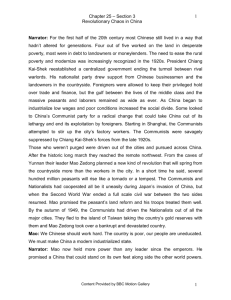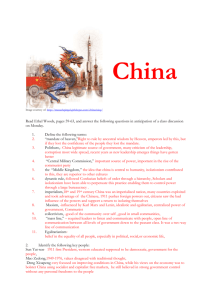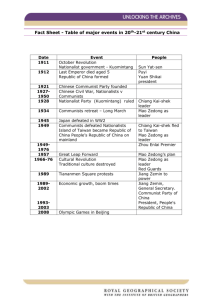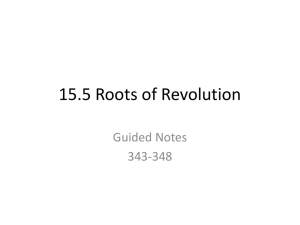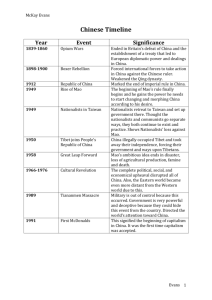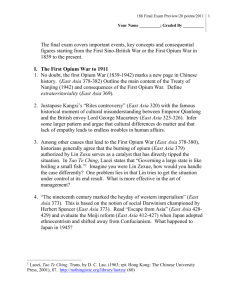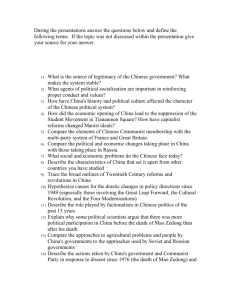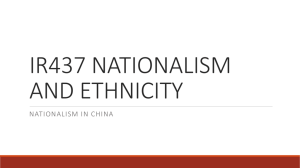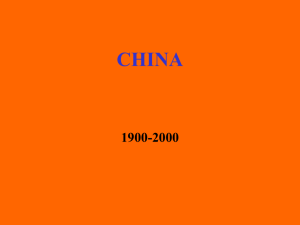History of China
advertisement
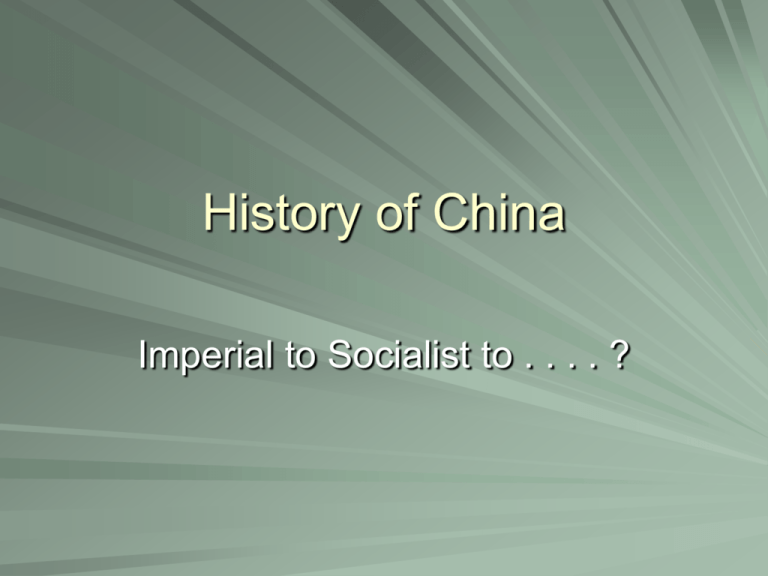
History of China Imperial to Socialist to . . . . ? The Power of Imperial China 14th century Largest Empire in the World in 1300 Agriculture; rice, later corn, sweet potatoes & peanuts Mining; salt, silver, tin, iron = $, jobs & products Industry: silk, cotton, porcelain, black powder Marco Polo Chinese culture was revered, respected by the west. Establishes Silk Road giving Europeans access to prized Chinese goods Silk Cotton Porcelain Black powder Isolationism China becomes increasingly isolationist and elitist. China turned its back on the world Chinese culture becomes stagnant & conservative. China fails to keep up with the west. Industrial Era China fails to industrialize. Industrial Britain reigns supreme in the west British build their empire all the way to India. British replace Spanish & Portuguese as primary traders Opium Wars 1800’s: Brits run out of silver & replace it w/trading Opium (from India) Rates of Opium addiction in China skyrocket; Opium use becomes a Chinese epidemic. China bans Opium Opium wars (1848) fought over British right to sell Opium in China. British win; lead to British “extraterritorial rights” China is a Paper Tiger Chinese defeat in the Opium Wars exposes an outdated military China is un-industrialized, fails to keep up with the west. Others gain “spheres of influence” in Chinese ports: – – – – US Russia Portugal Germany Boxer Rebellion 1899 Open Door Policy creates resentment for Westerners. “Society for Harmonious Fists” (Boxers) established to combat Western Influence Stages anti foreign rebellions in Tianjin & Beijing; killed over 200 westerners. Empress Cixi (SU-shi) voices support for rebellion but fails to act. Combined western armies crush rebellion. Government corruption leads to failed reform attempts Empress Cixi resists change One summer while she is away her nephew tries to make changes, he’s thrown out upon her return. 1902: Empress Cixi promises to study western countries, create a fully constitutional gov. in 15 years (by 1917). Revolution! 1912 Sun Yixian’s Nationalist movement overthrows Monarchy Sun turns control over to General Yuan Shikai China enters WWI 1916, General Shikai dies (civil war ensues) 1919 Versailles treaty 1925 Sun Yixian dies, succeeded by Chang Kai Shek Nationalists vs. Communists communists (who are aided by Lenin) are a significant portion of the Chinese nationalist movement. At first, Chiang Kai Shek promises to give them a voice in the movement. Shek (supported by Western capitalists) sees communists as a threat; tries to eliminate from Membership in the nationalist movement. Civil war Chiang Kai Shek’s nationalists vs. Mao Zedong’s communists (1918-1949) Nationalists are better organized and have better financial backing (West), score initial victories. WWII puts fighting on hold. – Japanese “Rape of Nanking” Communists turn the tide Mao takes his communists on the “Long March” across China, engaging Chiang’s nationalists strategically in guerilla warfare With further aid from Stalin, Mao’s communists defeat Chiang’s nationalists. Chiang Kai Shek flees to Taiwan. Emergence of Socialist rule: The People’s Republic of China Mao Rules Collectivizes Agriculture http://web.uncg.edu/dcl/courses/video_archive/jwjones/world/china/ChinaLandReform.rm?clo akport=8554,554,7070 ~5 million landlords & “undesirables” were killed in the collectivization process ~40% of Chinese land changed hands during the early 1950’s. http://web.uncg.edu/dcl/courses/china/u1/lesson1part3.asp The People’s Republic? Early economic successes & Soviet assistance lead to increases in quality of life (qol) Production is back at pre-war levels. Mao decides to open the government to public feedback. – 100 flowers campaign backfires. – Mao is scarred Economic Changes Continue Private businesses & entrepreneurial activities were gradually eliminated. GREAT LEAP FORWARD (farming) – Mao orders all peasants organized in to communes – All food was for “the state” – Peasants were required to form cottage industries smelting iron. – GLF is a miserable failure; results in 40+ million of deaths and useless/wasted iron. http://web.uncg.edu/dcl/courses/video_archive/jwjones/world/china /ChinaWorkers.rm?cloakport=8554,554,7070 Foreign Relations Stalin Snubs Mao Soviets continue to give Chinese military & financial aid Chinese criticize Soviet “softness” with the west in 1960’s, sever ties Cultural revolution Mao wanted to unify China in a communist culture Elimination of anti-communists “rightists” in Chinese culture Focused on youth: Red guards Witch hunts targeted – Intellectuals – Journalists – Teachers – Artists – priests. President Nixon Visits China (’72) Nixon called it: “The week that changed the world” 1st American TV images of China in decades Nixon quoted from Mao "Seize the hour! Seize the day! . . . . for our two peoples to rise to the heights of greatness which can build a new and better world” Sent a clear and dramatic message to everyone watching that a new relationship was being forged. Mao’s Demise Suffered a serious stroke in 1972 Paranoia led to massive purges of party leadership, including future party chairman Deng Xiaoping Died in 1976 Deng Xiaoping (’76-’81) Likeable: – moderate; fought against radicals in communist party – Intelligent – Practical – Likeable Tried to help rehabilitate victims of the Cultural Revolution Deng spearheads reforms Deng sought (with the support of party leadership) to put the 4 Modernizations at the top of China's agenda: – Agriculture – Industry – science and technology – defense Deng spearheads reforms Ended class labels & discrimination based on class Promotion within the party based more on rank than loyalty (switch from Mao’s era) Created a new state constitution that emphasized the rule of law under which even party leaders are theoretically held accountable Reforms continue in the 80’s Open Door Policy – Allowed foreign investment in China & foreign exchange – U.S. grants China “More favored nation” trade status Rural Reform – Decollectivization – Allowing rural & urban markets – Creation of new farming businesses (privatizing?) Industrial reforms – Relaxing of central government controls – Allow businesses to retain profits – Banking reforms Tiananmen Square April 22 - 100,000 students gather in the square to petition the government for change: democracy Tiananmen square June 3 – After weeks of failed negotiations with students, Chinese army uses tanks & armored vehicles to re-take Tiananmen square by force, killing over 1,000 students. Backlash International community (& U.S.) expressed concern over Chinese actions China fails to acknowledge any mishandling of the protests Modern China 1992: China announces a move to a “Socialist Market economy” (?) abandoning traditional communist goals. Opened State controlled businesses (SOE’s) to open to the stock exchange (the state would always retain the majority) Admitted to the World Trade Organization (WTO) and agreed to “open telecommunications & banking sectors to foreign competition & investment” (http://www.coba.unr.edu/faculty/parker/econ305/econ305f04lec5a.pdf) China has the largest trade surplus with the US of any country in the world, but also has millions unemployed. Modern China
